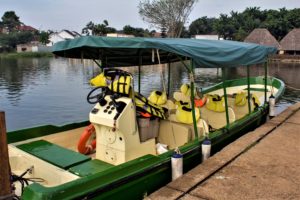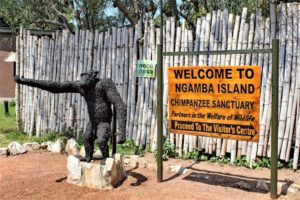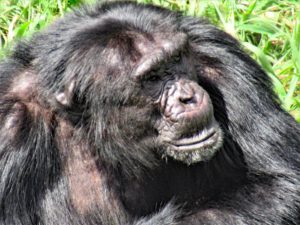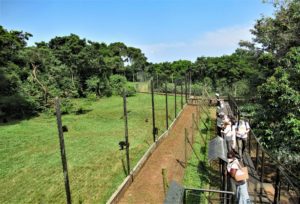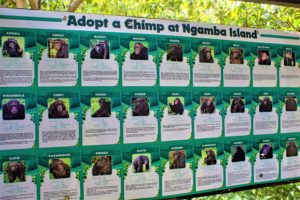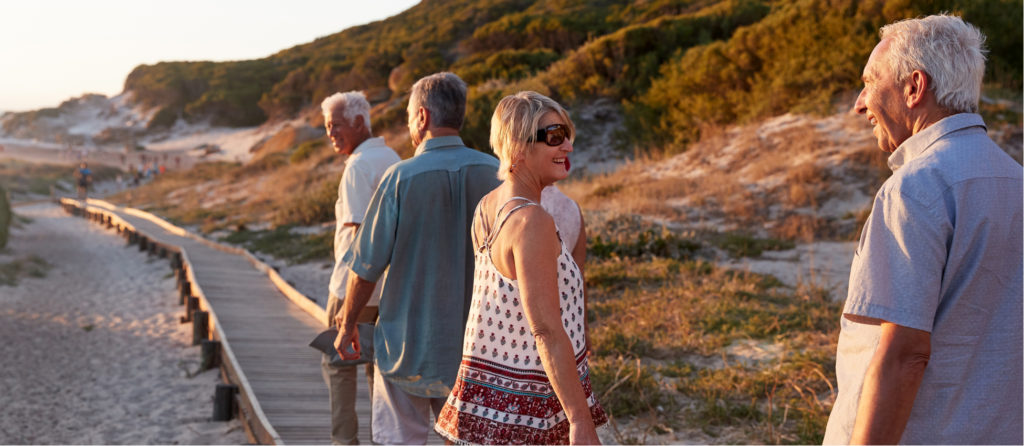Whilst staying in Uganda’s capital, Entebbe, we visited the Ngamba Island Chimpanzee Sanctuary whose website promised ‘an extraordinary experience you will never forget’.
The only way of getting to the island is by 12-seater boat across Lake Victoria, organised by the sanctuary. The journey time was said to be 45-minutes as the lake was flat, but it took over an hour as the waves got higher nearer the island.
Temperature checks were taken on arrival as colds or flu can be transmitted to the chimps, and masks were required at the chimp feeding area.
Winnie, a volunteer, greeted us and led us past a tree full of bright yellow weaver birds and their distinctive hanging nests. At the small gift shop we collected tea or coffee, before gathering in a thatched hut for her introduction.
The Sanctuary, established in 1998, was originally inhabited by a community who were relocated to a neighbouring island, and so each Sunday, the community are offered free visits where they educate the children not just about the chimps, but about waste management. The gift shops sells crafts made by the ladies on a commission basis, again to maintain community relationships. The site covers 100 acres and 95% is devoted to the chimps (this size of forest would normally only support 5 to 6 chimps which is why they need supplementary feeding).
There are currently 52 chimps which includes three babies, rescued by the Uganda Wildlife Authority. The last chimps, four from Sudan, were introduced around 10 years ago which is a sign that their education programme is being successful.
Although the female chimps are given a hormone implant when they mature, unplanned pregnancies happen. The implant may not work or in one case, the chimp scratched it out and so her baby was named Surprise.
All the chimps have names related to either their guardian, or how and who found them. Their life span is around 50 to 60 years, longer than those in the wild because of their pampered lifestyle.
Briefing over, it was time to walk to the feeding area. The chimps are fed four times a day: breakfast at 6am is posho, a maize flour porridge, followed by a varied selection of fruit and vegetables at 11.30am and 2.30pm. Their final feed is in the holding pen at 6pm, as this encourages them to come in to sleep in high hammocks lined with straw.
A raised metal platform overlooked a fenced grassy area where the chimps were already waiting. Up a short flight of steps was an elevated area where we could photograph without the wires in the way. They were an absolute delight to watch, particularly as some had developed ways of attracting attention which included beating their chest, putting up their hand, blowing raspberries or making a pant noise.
Food finished, the chimps wandered back to the forest giving us time to read more about the personal profiles. Each had a photo and listed the year of birth where known, sex, where they were rescued from (mainly Uganda and the neighbouring Democratic Republic of Congo) and the date, followed by their distinguishing features, and characteristics.
We were encouraged to become either a guardian or friend of the chimpanzees whereby our substantial donation would support the work of the sanctuary in return for photographs and chimp updates.
The chimps and volunteers are segregated by an electric fence, which juts out in the lake as although the chimps are generally afraid of water, Sunday isn’t and we heard the story of how a local boat tied up illegally on the island and how Sunday found his way into it, drifted out to see and had to be rescued.
Tour over, an optional lunch was available if ordered on arrival.
On the return journey, we crossed the equator although it was a slightly underwhelming experience.
